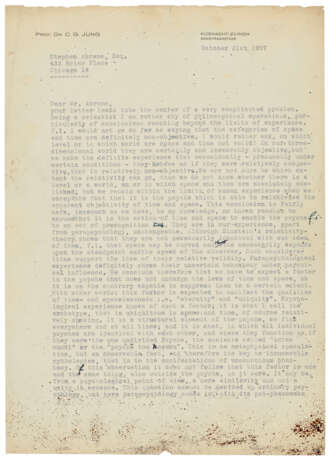ID 1109095
Лот 295 | Carl Jung (1875-1961)
Оценочная стоимость
£ 8 000 – 12 000
Typed letter signed (‘C.G. Jung’) to Stephen Abrams, [Küsnacht], 21 October 1957
In English. 2 pages, 295 x 209mm, headed letter-paper, a few ink corrections. Provenance: Stephen I. Abrams (1938-2012) – Sotheby's, 29 & 30 April 1980, lot 287.
The immutable archetype: an important letter setting forth his concept of the anima mundi – ‘the key to innumerable mythologies’ – in relation to the theory of relativity and discussing synchronicity. Jung has received a reply to his letter of 20 June [see previous lot]: ‘Your letter leads into the center of a very complicated problem. Being a scientist, I am rather shy of philosophical operations, particularly of conclusions reaching beyond the limits of experience. F[or] i[nstance] I would not go as far as saying that the categories of space and time are definitely non-objective. I would rather ask, on which level or in which world are space and time not valid?’, going on to define his understanding of the status of this experienced objectivity, concluding that within the limits of human experience, it is the psyche which is able to make relative the apparent objectivity of time and space and that we have no known reasons to assume that it is the action of time and space that, for example, enables the psyche to commit an act of precognition. ‘They are in our experience, apart from parapsychology, unchangeable. Although Einstein's relativity-theory shows that they are not necessarily identical with our idea of them, for instance that space may be curved and that time necessarily depends upon the standpoint and the speed of the observer. Such considerations support the idea of their relative validity. Parapsychological experience definitely shows their uncertain behaviour under psychical influence. We conclude therefore that we have to expect a factor in the psyche that does not undergo the laws of time and space, as it is on the contrary capable to suppress them to a certain extent. This factor, which must be independent of space and time, or exhibiting ‘eternity’ and ubiquity’, is what he defines as the archetype: ‘It is a structural element of the pysche, we find everywhere and at all times; and it is that, in which all individual psyches are identical with each other, and where they function as if they were the one undivided Psyche, the ancients called “anima mundi” or the “psyche tou kosmou”. This is no metaphysical speculation, but an observable fact, and therefore the key to innumerable mythologies, that is to the manifestations of unconscious phantasy’. Psychology must necessarily fall short in the study of this realm, which is where parapsychology takes over: in the second half of the letter Jung explores the difference between the collective and individual psyche and offers some of his observations on the co-occurrence of archetypes and parapsychological phenomena, before turning to synchronicity – ‘I think you are correct in assuming synchronicity, though prectically [sic] a relatively rare phenomenon, is an all-pervading factor or principle in the universe, i.e. in the Unus Mundus, where there is no incommensurablity between socalled Matter and socalled Psyche’ – and the enigma of the ‘natural number’. Jung closes by accepting an honorary membership of the Parapsychology Club at Chicago University and observes that it is ‘none too early, that somebody in the West takes notice of synchronicity. As I have been informed, the Russians have already caught hold of my paper’.
An important statement of concepts central to Jung's work and of his position in the history of ideas. The editors of his selected correspondence, where this and the following two letters are printed, point out that towards the end of his life Jung used letters (of ‘unique literary and pyschological value’) to express or work out ideas which he felt unwilling or unable to communicate in publications: ‘In this way many of his letters contained new creative ideas and a running commentary on his work’. Stephen Abrams was at the time attending the Parapsychological Laboratory at Duke University under Professor J. B. Rhine and planned to work on the experimental confirmation of Jung's theory of synchronicity. He moved to Britain in 1960 to work on an extra-sensory perception at Oxford and head its parapsychology laboratory.
| Автор: | Карл Густав Юнг (1875 - 1961) |
|---|---|
| Место происхождения: | Швейцария |
| Автор: | Карл Густав Юнг (1875 - 1961) |
|---|---|
| Место происхождения: | Швейцария |
| Адрес торгов |
CHRISTIE'S 8 King Street, St. James's SW1Y 6QT London Великобритания | |||||
|---|---|---|---|---|---|---|
| Предосмотр |
| |||||
| Телефон | +44 (0)20 7839 9060 | |||||
| Комиссия | see on Website | |||||
| Условия использования | Условия использования |











